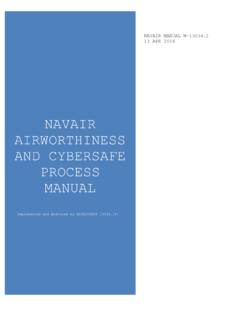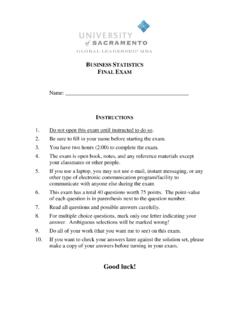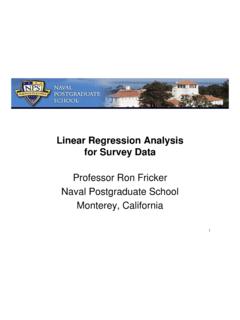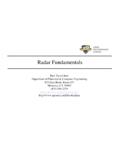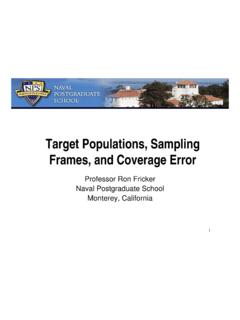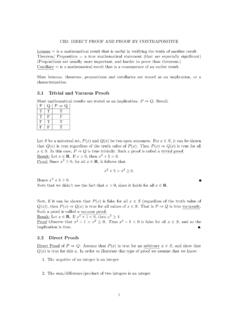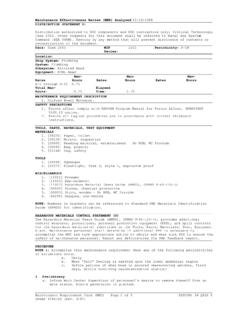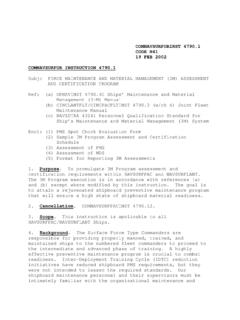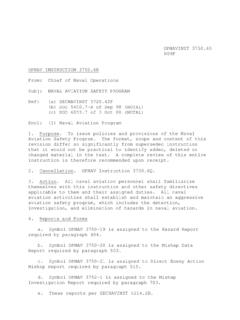Transcription of DEPARTMENT OF THE NAVY COMMANDER NAVAL AIR …
1 DEPARTMENT OF THE NAVY COMMANDER NAVAL AIR FORCES BOX 357051 SAN DIEGO CALIFORNIA 92135-7051 COMNAVAIRFORINST N45 20 Nov 17 COMNAVAIRFORINST From: COMMANDER , NAVAL Air Forces Subj: GUIDANCE FOR THE OPERATION OF DEPARTMENT OF NAVY GROUP 1 AND 2 UNMANNED AIRCRAFT SYSTEMS Ref: (a) SECNAV WASHINGTON DC 271307Z Jul 16 (ALNAV 052/16) (b) CNAF (c) OPNAVINST (d) OPNAVINST (e) CJCSI (f) 14 CFR Part 91 (g) DOD/FAA memo of 16 September 2013 (h) DODI , Use of International Airspace by Military Aircraft and for Missile and Projectile Firings of 2 June 2015 (i) JP 3-52 of 13 November 2014 (j) OPNAVINST (k) NAVMED P-117 (l) DCMA INST (m) NAVAIRINST (n) OPNAVINST (o) NAVSEAINST (p) DEPSECDEF memo 15-002 of 17 February 2015 1.
2 Purpose. In response to reference (a), this instruction provides DEPARTMENT of Navy (DoN) guidance on program of record (POR) and non-program of record (Non-POR) group 1 and 2 unmanned aircraft systems (UAS) operations, including command oversight responsibilities and minimum operator qualifications. 2. Applicability. This instruction applies to all group 1 and 2 UAS operations conducted by Navy and Marine Corps activities and those operating the UAS to include military, civilian and contractor personnel. The Marine Corps will publish detailed complementary guidance and policy to meet the intent of this instruction.
3 3. UAS Command Responsibilities. There are two essential command authorities assuming responsibility for UAS operations: the aircraft controlling custodian (ACC) or designated approval authority (DAA) and the aircraft reporting custodian (ARC). COMNAVAIRFORINST 20 Nov 17 2 a. Flag-level command oversight authorities and responsibilities (1) ACC/DAA responsibilities. Within the NAVAL Aviation Enterprise (NAE), the management and operation of aircraft, including group 1 and 2 UAS, is the responsibility of an ACC.
4 An ACC is responsible for exercising administrative control of assignment, employment and logistic support of group 1 and 2 UAS under their cognizance. A DAA is the flag officer, or SES equivalent, who assumes ACC authorities and responsibilities when an ACC is not designated. The ACC or DAA is responsible for designating in writing UAS ARCs under their cognizance. ACC responsibilities can be found in references (b) through (d). The ACC or DAA must ensure the designated ARC maintains the requisite personnel, training, equipment and infrastructure to support safe flight operations in compliance with DoN policies and instructions.
5 Compliance must be ensured through DAA-conducted periodic evaluations of approved UAS programs. (2) Establishment of ACC or DAA for UAS programs. Each command establishing a new group 1 or 2 UAS operation must provide written notification to COMNAVAIRFOR (N45) and NAVAIR AIRW orks documenting the establishment of the ACC or DAA. This notification should include ACC or DAA contact information and a list of designated ARC(s) under the cognizance of the ACC or DAA. (3) ACC or DAA inventory responsibilities. The ACC or DAA must maintain an inventory of all group 1 and 2 UAS in subordinate commands and units. Inventories must, at a minimum, include UAS configuration and status, and the ARC responsible for UAS operations.
6 UAS inventory may be tracked in the aircraft inventory readiness reporting system (AIRRS), combat observation and lasing team, g lobal combat support systems - marine corps (GCCS-MC), the small unmanned aircraft systems manager (SUASMAN) system or other method deemed appropriate by the ACC or DAA. (4) UAS crewmember designation authority. The ACC or DAA is responsible for delegating UAS crewmember designation authority to the ARC or higher echelon COMMANDER . This delegation may be included in the documentation establishing the ARC. (5) Carrier strike group commanders will be designated DAAs for any group 1 and 2 UAS operated from aircraft carriers.
7 B. Unit/command-level aircraft reporting custodian authorities and responsibilities (1) ARC. The ARC is the lowest echelon of command accepting responsibility for group 1 and 2 UAS operations, as designated by the Chief of NAVAL Operations (CNO), ACC or DAA. ARC responsibilities can be found in references (b) through (d). An ARC is typically an O-5 level commanding officer, but may be a military officer or government civilian leading an organizational component as deemed appropriate by the ACC or DAA. The ARC is responsible for the safe operation of assigned UAS. COMNAVAIRFORINST 20 Nov 17 3 (2) UAS crewmember designations.
8 ARCs are authorized to approve UAS crew qualifications and certifications after ensuring each UAS crewmember has completed the requisite training for the applicable crewmember classification. UAS crewmember classifications are provided in reference (b), chapter 14, subparagraph ARCs must issue a written designation letter to each qualified individual upon their designation. Copies of each designation letter must be retained in the individual crewmember s training jacket. c. Intermediate commands - a uthorities and responsibilities. Commands in the administrative chain of command between the ACC or DAA and the ARC should have an appropriate working knowledge of UAS operations commensurate with their level of responsibility, to include general oversight, funding, manning, training, operations, safety, standardization, maintenance and any other topic areas that may apply.
9 These commands are considered part of the safety and endorsement chain of command in the event of a mishap that meets mishap reporting thresholds as identified in reference (d). 4. Minimum group 1 and 2 UAS crew training and qualification requirements. The ARC is responsible for establishing UAS crew training and qualification requirements. The following minimum air vehicle operator (AVO) qualifications must be met prior to group 1 and 2 UAS operations inside of national class D, E or G airspace; special use airspace ( , military operating areas, prohibited areas, restricted areas, warning areas, etc.); j oint operating areas; combat or contingency airspace; or international airspace.
10 Additional AVO qualifications are required to conduct operations inside national class A, B or C airspace and under instrument flight rules (IFR). See reference (b) for additional information. a. Basic UAS qualification (BUQ) training. Minimum BUQ level I and BUQ level II training. BUQ I and BUQ II training may be found online at the Joint Knowledge Online (JKO) website via Search basic unmanned aircraft systems qualification after logging into the website to access the appropriate level of BUQ training. See references (b) and (e) for additional information on BUQ qualifications. b. Airspace operations. UAS crew must be trained in procedures applicable to the airspace in which they will operate.
